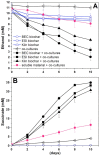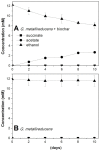Promoting interspecies electron transfer with biochar
- PMID: 24846283
- PMCID: PMC4028902
- DOI: 10.1038/srep05019
Promoting interspecies electron transfer with biochar
Abstract
Biochar, a charcoal-like product of the incomplete combustion of organic materials, is an increasingly popular soil amendment designed to improve soil fertility. We investigated the possibility that biochar could promote direct interspecies electron transfer (DIET) in a manner similar to that previously reported for granular activated carbon (GAC). Although the biochars investigated were 1000 times less conductive than GAC, they stimulated DIET in co-cultures of Geobacter metallireducens with Geobacter sulfurreducens or Methanosarcina barkeri in which ethanol was the electron donor. Cells were attached to the biochar, yet not in close contact, suggesting that electrons were likely conducted through the biochar, rather than biological electrical connections. The finding that biochar can stimulate DIET may be an important consideration when amending soils with biochar and can help explain why biochar may enhance methane production from organic wastes under anaerobic conditions.
Figures







References
-
- Lehmann J. A handful of carbon. Nature 447, 143–144 (2007). - PubMed
-
- Zheng H. et al. Characteristics and nutrient values of biochars produced from giant reed at different temperatures. Bioresour. Technol. 130, 463–471 (2013). - PubMed
-
- Chan K., Van Zwieten L., Meszaros I., Downie A. & Joseph S. Using poultry litter biochars as soil ammendments. Soil Res. 46, 437–444 (2008).
-
- Lehmann J. et al. Biochar effects on soil biota: A review. Soil Biol. Biochem. 43, 1812–1836 (2011).
Publication types
MeSH terms
Substances
LinkOut - more resources
Full Text Sources
Other Literature Sources
Molecular Biology Databases

